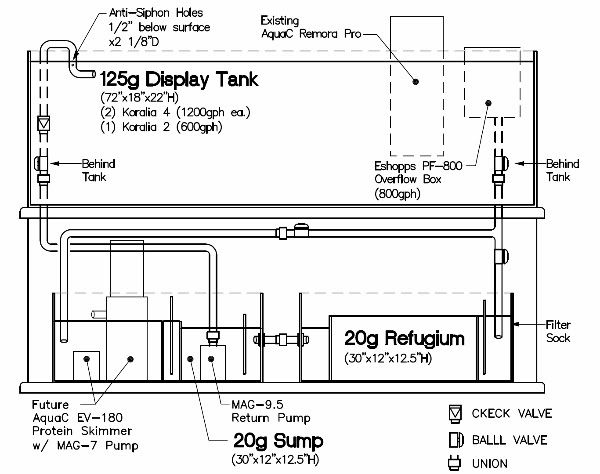Originally Posted by
truehle
http:///forum/post/2921666
I just just got carried away with control of the return. I tend to forget my process control education from college. Too many variables just leads to a hard if not impossible system to control.
I will take your advice. I just can't quite seem to get it in my head that as long as my overflow is greater than my return pump, I'll be ok.
My friend I would like to address your concern over the idea that your overflow has to be greater then your GPH return.

Lets assume your tank is ready for the introduction of water. You start filling your tank and when the water level reaches your overflow box (which is nothing more then a fixed weir) you stop. This is the total volume of water in your DT. As you continue to add water it crests the weir and is gravity feed to your sump/refug. Were you to continue to add water you would fill and then overflow your sump/refug. (Not a good thing). Lets say we stop two inches above the suction side of your return pump. Now we start your pump the water level in you sump goes down as you charge your influent lines and add water to your DT. The level rises and you crest the weir completing the loop of water. To make sure your water level in your sump does not fall below the suction level of your pump you add water. You do not have a variable speed pump so you have a constant GPH, the water level in your sump remains constant. Now we want to adjust the level in your sump/refug. How do we do this? We add or remove water volume from the system. If we add water to your DT it will increase the speed at which the water enters your sump/refug the increased speed increases volume in your sump/refug the pump remaining at a constant is still putting back the same amount of water so the level in your sump rises untill you reach an equilibrium. Conversely if we want to lower the level of water in our sump we remove some water from our DT, less water over the weir slower speed to our Sump. Slower speed less volume, lower level again because our pump is at a constant rate of delivery. The overflow rate of your overflows box varies why the volume of water in your tank.
What I would do at this point is to turn off the pump. There is going to be a certain amount of back flow until your siphon brake mechanisms take effect. If you think you will overflow your sump, start the pump. Remove some water from your DT thus lowering the level in your sump. Turn off the pump again monitor the level of your sump with the back flow. Repeat until you get to a safe level. With your pump turned off. That is the total volume of your system. I would then put a mark on the sump at the water level. This mark will be your gauge for top offs. As you loose water through evaporation the level in your sump will lower. Add water to your tank until the level comes up to the mark in your sump and you are good to go.
I hope this makes some sense? If it does to anyone out there PLEASE explain it to me I think I have confused myself









